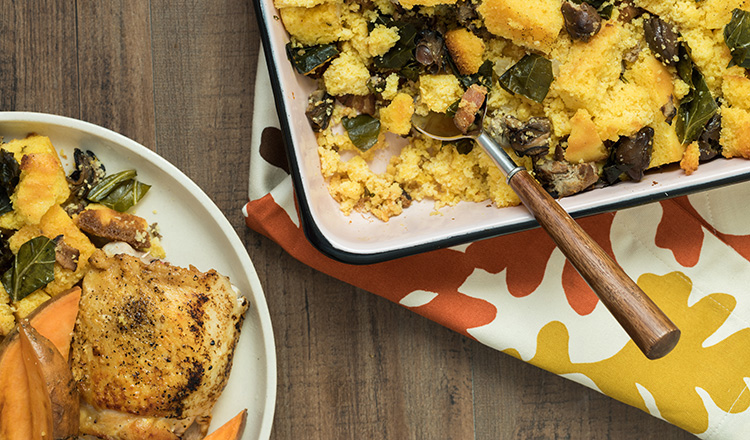
Stuffing (or maybe you call it dressing?) is highly personal. You might follow the same family recipe each year, or maybe you go out in search of something new and exciting. More often than not, you might be let down. This isn’t because the recipes are bad, but it’s because it’s not your recipe.
The bright side of stuffing is that if you follow a few very basic principles, you can create your own flavorful, moist, and texturally exciting side—without a recipe!
Here are our best tips:
- Consider the texture you really like in a stuffing, and choose your bread accordingly. If you like a softer, more cohesive stuffing that reminds you of the one out of the box, then choose the dried bread cubes you can easily find at the grocery store this time of year. They’re typically made out of sandwich bread, like white bread or whole wheat bread, so once soaked, they won’t hold much of their texture. That’s right on target for lots of folks!
Of course, you can also make these same croutons using white or wheat sandwich bread, brioche, or other soft loaves, like grocery store “French bread.” Just dry it out in the oven before you make the stuffing.
If you like a more craggy stuffing with dryer bits to crunch on, you’ll want to use torn bits of crusty bread, like from a nice baguette or sourdough. Tear the bread into bite size pieces (this will maximize nooks and crannies!), and toast it lightly in the oven.
- Use plenty of aromatic ingredients. This usually means carrot, onion, celery, and garlic, and sure, these are standard for stuffing. But it’s your stuffing, so experiment with more flavorful options like leeks, fennel, and parsnips. If you cook them low and slow with plenty of butter or even better, chicken fat (schmaltz, the best Thanksgiving ingredient!), you’ll achieve the caramel-like richness that is the foundation of most incredible dishes.
Herbs are an integral part of making stuffing taste like stuffing. If you’re after that classic Thanksgiving flavor, you’ll want to add some minced fresh sage, but thyme and oregano are also lovely base notes.
- Add something meaty, whether that’s sausage, pancetta, or well-seared mushrooms. Not only will they contribute flavor, but they will be an appealing contrast in texture.
- Dress your stuffing, but don’t gild the lily, as they say. We like adding cooked chicken livers, smoked oysters, or even caramelized apples—but not all at once! Choose one or two supporting characters and let them shine.
- Use homemade broth (or high-quality store-bought). We try not to be preachy about things like this, because we know making broth is a little time consuming. But it really does influence the flavor of your stuffing more dramatically than you might think. If you don’t have time to make broth, consider this quick kitchen hack: simmer 2 quarts of low-sodium chicken broth with 1 lb of chicken drumsticks, a handful of chopped carrots, and half an onion, for about 30 minutes.
- Stir an egg (or two if you’re making a big batch) into your mixture to help bind it. If your stuffing still feels dry, like it won’t hold together, add more broth.
- Toss all of your ingredients with the broth in a large bowl before you transfer them to the baking dish. Give it plenty of time to soak in the bowl, tossing it occasionally and adding more broth as needed. This will make sure the pieces on top are as soaked through as the ones on the bottom. Make sure to taste the unbaked stuffing for seasoning before you bake it.
- Finally, even though we’re calling it stuffing, it’s best for everyone if you prepare and bake your stuffing outside of the turkey. Fill the turkey with other flavorful ingredients, like onions, apples, lemons, and herbs.
If after all of these ideas, you’re still looking for a little inspiration, take a peek at our Cornbread Stuffing with Smoked Oysters. It’s a classic!
